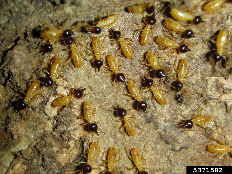Need assistance? Call 800.996.4402

Conehead termites are an invasive species native to the Caribbean that was first introduced to the U.S. in 2001. They were originally called “tree termites,” but were renamed conehead termites to alleviate the misconception that this pest is only found in trees.
Unlike most termites, the conehead termite does not rely on underground tunneling to travel. Instead, they forage on the ground like ants, allowing them to spread quickly.
Conehead termites are an extremely aggressive termite species known for causing widespread property damage in a short period of time. Additional research into the species and treatment options are critical to controlling this destructive pest’s spread, or else millions of dollars in damage can be expected.
Conehead termites build dark brown “mud” tubes and freestanding nests on the ground, in trees or in wooden structures. The nests can be up to 3 feet in diameter and have a hard surface of chewed wood.
Because of their unique habits, conehead termites have proven difficult to control with existing treatment methods. The nest must be located and destroyed, and the structure may require repeated treatments in order to gain control. Costs associated with treating conehead termites are typically higher than other termite species, and homeowner insurance policies do not usually cover wood boring insect damage. If you suspect a conehead termite infestation, it is important to contact a licensed pest professional promptly.
For the very best food safety consulting, auditing and training, please visit our strategic partner, CFS Food Safety